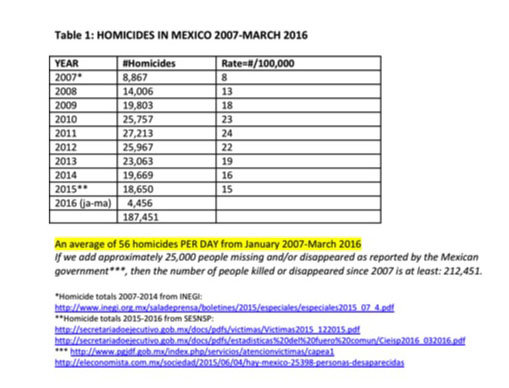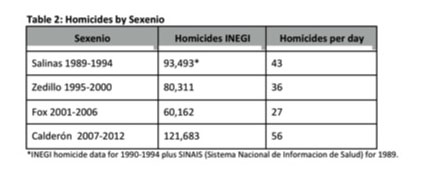‘Bandas Criminales’ and a Post-accord Colombia
Colombia will likely remain on the negative side of the security spectrum unless a comprehensive series of preventative measures are put in place to restrict the proliferation of violence.
Colombia will likely remain on the negative side of the security spectrum unless a comprehensive series of preventative measures are put in place to restrict the proliferation of violence.
Some Thoughts on the Possible Imminent Extradition of Chapo Guzman
Molly Molloy
SWJ El Centro Fellow Molly Molloy shares her thoughts on the possible imminent extradition of El Chapo Guzmán. [1] SWJ
Various leaders of Mexican criminal organizations have been killed, jailed, and/or extradited since 2007. Their activities alone did not cause the explosion of violence, nor has the violence diminished significantly with these people being dead, in jail or extradited. Is El Chapo really as important/powerful/controlling as he is portrayed in the media? I don’t know the answer to that, but considering how long he has been around, both in jail and out, I don't see any significant changes in the overall level of violence in Mexico based on whether or not he is in or out of jail.
The violence exploded in 2007, shortly after Felipe Calderón sent thousands of military troops and federal police forces into the towns and cities of Mexico. Consider that this militarization of the so-called "drug war" caused the huge increase and continuation of violence, not the killing, capture and/or extradition of the various criminal kingpins.
Some scholars [2] have looked for correlations between presence of the military and increasing violence as measured by homicides. And they find them, especially in the case of the hyper-violence that occurred in Ciudad Juárez from 2008-2012. It is also worth noting that at least seven execution-style murders have already occurred in the first seven days of May 2016. The overall numbers of murders in Juárez are greatly diminished, but the violence continues at the rate of slightly more than one murder per day in the city.
Did the Military Interventions in the Mexican Drug War Increase Violence? [3]
This question is common and unresolved when discussing the Mexican drug war.
It is not so simple as to believe that militarization is the singular cause of the violence. We have to look at general social and economic conditions, perhaps most significantly the social upheavals, population movements and even armed rebellions that came after the huge economic and political changes spurred by implementation of the NAFTA in 1994. In Table 1 and table 2 (below), it is interesting to look at the high number of homicides during the Salinas sexenio. In terms of population growth since, it was probably almost as violent as Calderón's term.
It is also necessary to consider what will be revealed (or not) if Guzmán faces trial in federal court in the United States. Other high level traffickers who have been brought to the U.S. have made plea deals rather than go through a full trial. It is doubtful that either the U.S. or the Mexican governments have an interest in full disclosure of recent “arrangements” with the Sinaloa Cartel. [4]
As reported in The Guardian, “The young Mexican drug lord Jesus Vicente Zambada Niebla made headlines three years ago when he claimed the United States government had protected his father's drug cartel in return for providing information against rival cartel members. Now, with the revelation this week that Zambada's legal team and the US attorney's office signed a secret plea agreement a year ago, he has struck a deal of his own.” [5][6] Zambada the son of “El Mayo” Zambada (Ismael Zambada García), El Chapo’s partner in the leadership of the Sinaloa cartel. The following quotes provide insight into his “arrangements” with U.S. prosecutors:
The full plea agreement is available here:
The Statistics on Violence
Below is a summary of the data available on homicides in Mexico from official sources. For a more detailed look behind these numbers see: The Mexican Undead: Toward a New History of the “Drug War” Killing Fields. [10]
Table 1: HOMICIDES IN MEXICO 2007-MARCH 2016

An average of 56 homicides PER DAY from January 2007-March 2016
If we add approximately 25,000 people missing and/or disappeared as reported by the Mexican government***, then the number of people killed or disappeared since 2007 is at least: 212,451.
*Homicide totals 2007-2014 from INEGI: http://www.inegi.org.mx/saladeprensa/boletines/2015/especiales/especiales2015_07_4.pdf
**Homicide totals 2015-2016 from SESNSP:
http://secretariadoejecutivo.gob.mx/docs/pdfs/victimas/Victimas2015_122015.pdf
*** http://www.pgjdf.gob.mx/index.php/servicios/atencionvictimas/capea1
http://eleconomista.com.mx/sociedad/2015/06/04/hay-mexico-25398-personas-desaparecidas
Homicides have gone down slightly during the first three years of Enrique Peña Nieto’s sexenio, but the average # of homicides PER DAY still stands at about 56—the number for all 6 years of Calderón’s term. And that number was DOUBLE the number of homicides per day during the sexenio of Vicente Fox.
Table 2: Homicides by Sexenio

*INEGI homicide data for 1990-1994 plus SINAIS (Sistema Nacional de Informacion de Salud) for 1989.
Editor’s note: At this time the extradition of El Chapo (Joaquín Guzmán Loera) remains a future potential. There is significant pressure from US authorities for extradition. While a Mexican judge cleared El Chapo for extradition his lawyers have appealed that ruling and several procedural steps, including approval by Mexico’s Foreign Ministry remain. Guzmán was recently moved from Altiplano prison to Cefereso No. 9, a prison on the outskirts of Cd. Juárez.
Notes:
[1] The potential extradition of Mexican drug lord Joaquín Guzmán Loera (El Chapo) to the United States appears more likely and may be imminent. See Azam Ahmed and Paulina Villegas, “Judge in Mexico Says El Chapo Can Be Extradited to U.S.,” New York Times, 09 May 2016 at http://www.nytimes.com/2016/05/10/world/americas/mexico-el-chapo-joaquin-loera-guzman.html?_r=0 and Dolia Estevez, “Is Mexican Drug Lord 'El Chapo' Guzmán's Extradition Imminent?” Forbes, 09 may 2016 at http://www.forbes.com/sites/doliaestevez/2016/05/09/is-mexican-drug-lord-el-chapo-guzmans-extradition-imminent/#47cd678c29d9.
[2] This question is a recurrent theme when reviewing the Mexican drug war. See for example Valeria Espinosa and Donald B. Rubin, “Did the Military Interventions in the Mexican Drug War Increase Violence?” The American Statistician, Vol. 69, No. 1, 2015, pp. 17-27 at http://www.tandfonline.com/doi/abs/10.1080/00031305.2014.965796.
[3] Ibid.
[4] Associated Press in Chicago, “Top Sinaloa cartel member co-operating with police in Guzman case,” The Guardian, 10 April 2014 at http://www.theguardian.com/world/2014/apr/10/sinaloa-cartel-cooperating-drug-trafficking-chapo-guzman.
[5] Ibid. The Guardian, 10 April 2014.
[6] Ibid. See also Bill Conroy, “US Court Documents Claim Sinaloa “Cartel” Is Protected by US Government,” The Narcosphere, 31 July 2011 at http://narcosphere.narconews.com/notebook/bill-conroy/2011/07/us-court-documents-claim-sinaloa-cartel-protected-us-government.
[7] The Guardian, 10 April 2014.
[8] Bill Conroy, “Zambada Niebla’s Plea Deal, Chapo Guzman’s Capture May Be Key To An Unfolding Mexican Purge,” The Narcosphere, 12 April 2014 at http://narcosphere.narconews.com/notebook/bill-conroy/2014/04/zambada-niebla-s-plea-deal-chapo-guzman-s-capture-may-be-key-unfolding-. See also Bill Conroy, “Assassinated DEA Agent Kiki Camarena Fell in a CIA Operation Gone Awry, Say Law Enforcement Sources,” The Narcosphere, 27 October 2013 at http://narcosphere.narconews.com/notebook/bill-conroy/2013/10/assassinated-dea-agent-kiki-camarena-fell-cia-operation-gone-awry-say-l for additional background.
[9] ‘High-Level Sinaloa Cartel Member’s Guilty Plea Unsealed; Zambada-Niebla’s Cooperation With U.S. Revealed,” Chicago: U.S. Attorney’s Office, Northern District of Illinois, 10 April 2014 at https://www.justice.gov/usao-ndil/pr/high-level-sinaloa-cartel-member-s-guilty-plea-unsealed-zambada-niebla-s-cooperation-us.
[10] Molly Molloy, “The Mexican Undead: Toward a New History of the “Drug War” Killing Fields,” Small Wars Journal, 21 August 2013 at http://smallwarsjournal.com/jrnl/art/the-mexican-undead-toward-a-new-history-of-the-“drug-war”-killing-fields.
A Redeye Man Portable Air Defense System seized was in the possession of armed personnel belonging to La Linea.
Due in part to the rapid digital penetration of the Internet and social media over the past decade, there are novel ways of tracking cartel and gang activity.
While cartel drones are typically considered a tool for smuggling, they are increasingly seen as having application for other purposes including espionage, surveillance, and as weapons.
Mexico's Illicit Drug Networks and the State Reaction
![]()
SWJ-EL Centro Fellow Nate Jones just published the book Mexico's Illicit Drug Networks and the State Reaction. The text is published by Georgetown University Press. The following synopsis describes the book:
Mexican drug networks are large and violent, engaging in activities like the trafficking of narcotics, money laundering, extortion, kidnapping, and mass murder. Despite the impact of these activities in Mexico and abroad, these illicit networks are remarkably resilient to state intervention.
Drawing on extensive fieldwork and interviews with US and Mexican law enforcement, government officials, organized crime victims, and criminals, Nathan P. Jones examines the comparative resilience of two basic types of drug networks―"territorial" and "transactional"―that are differentiated by their business strategies and provoke wildly different responses from the state. Transactional networks focus on trafficking and are more likely to collude with the state through corruption, while territorial networks that seek to control territory for the purpose of taxation, extortion, and their own security often trigger a strong backlash from the state.
Timely and authoritative, Mexico's Illicit Drug Networks and the State Reaction provides crucial insight into why Mexico targets some drug networks over others, reassesses the impact of the war on drugs, and proposes new solutions for weak states in their battles with drug networks.
Dr. Nathan P. Jones received his PhD from the University of California, Irvine, is a SWJ-El Centro Fellow, and is a nonresident scholar in drug policy and Mexico studies at the Baker Institute at Rice University. He currently serves as an assistant professor in the Department of Security Studies at Sam Houston State University.
Old and New Insurgency Forms by Dr. Robert Bunker, Strategic Studies Institute monograph
This monograph creates a proposed insurgency typology divided into legacy, contemporary, and emergent and potential insurgency forms, and provides strategic implications for U.S. defense policy as they relate to each of these forms. The typology clusters, insurgency forms identified, and their starting dates are as follows, Legacy: Anarchist (1880s), Separatist—Internal and External (1920s), Maoist Peoples (1930s), and Urban Left (Late-1960s); Contemporary: Radical Islamist (1979), Liberal Democratic (1989), Criminal (Early 2000s), and Plutocratic (2008); and Emergent and Potential: Blood Cultist (Emergent), Chinese Authoritarianism (Potentials; Near to Midterm), and Cyborg and Spiritual Machine (Potentials; Long Term/Science Fiction-like). The most significant strategic implications of these forms for U.S. defense policy are derived from the contemporary Radical Islamist form followed by the contemporary Criminal and emergent Blood Cultist forms. If the potential Chinese Authoritarianism form should come to pass it would also result in significant strategic impacts.
Bloodbath on the beaches: The Mexican drug gangs riding on JET SKIS to blast victims ‘James Bond-style’.
To better understand the challenges of securing the border, this article analyzes the Border States environment, the human element, and then look towards the future.
While it contends with the Islamic State and al-Qaida an insurgency intent on challenging the sovereignty of the U.S. government is already here.